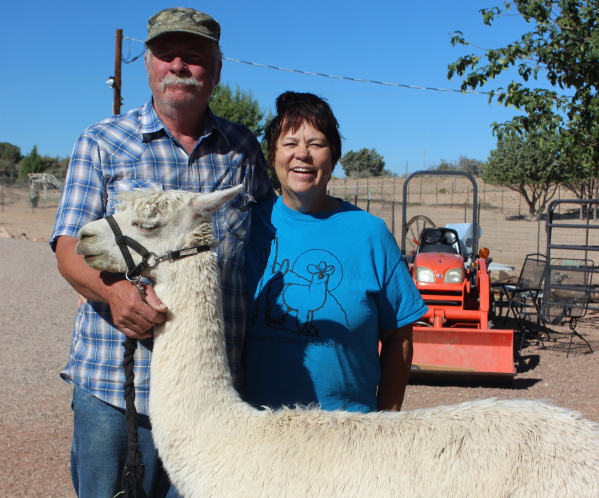Outdoors: Alpaca ranch near Kingman worth a side trip
Ahhh, the elusive alpaca! Prolific producer of fine fleece for luxurious clothing, patient poser for photos in geography books, whose very name regularly rescues crossword puzzle devotees, the animal itself rarely seen in North America.
That's changing, now, and it's worth taking a look if you are traveling through Kingman, Ariz. Alpacas of the Southwest, a ranch lying only a five-minute drive off Interstate 40, offers visitors a chance to actually meet this storied creature. And old or young, the visitors are typically charmed.
Owners Ron and Anna Nyberg have 39 alpacas on the ranch, including a 2-month-old. Originally from Southern Nevada, the couple was searching for a better quality of life in a rural atmosphere, and at the same time, they became interested in the alpaca business. After immersing themselves in learning all about alpacas for a few years, the couple bought the property west of Kingman and started their business in 2005.
Many people confuse alpacas with llamas. They're cousins, part of the South American branch of the camelid clan, but their bloodlines are long parted, for they were domesticated from different wild ancestors more than 6,000 years ago. Alpacas ever since have been raised for their fleece. They stand about 3 feet tall at the shoulder and typically weigh 100 to 175 pounds. Llamas, often a foot taller, sometimes weigh as much as 400 pounds, and have always earned their fodder as beasts of burden and sometimes by guarding other animals from predators. Alpacas are known to be more docile than llamas and are kid-friendly. And they can't bite to speak of, for they have teeth only on their bottom jaws.
They do, however, produce a remarkable fleece, warm as sheep's wool but much lighter and softer. It contains none of the lanolin or guard hairs found in sheep's wool, which irritate the skin of some humans, so alpaca fleece is considered hypoallergenic.
The Nybergs' alpacas are shorn yearly in April, and each produces about 5 to 10 pounds of fleece depending on its size. The Nybergs don't personally shear the animals but have professional shearers, an Amish group from Ohio, visit annually to do the honors. Once the fleece is processed, it is made into yarns, socks, sweaters, scarves, blankets and other fiber products. Different areas of the alpaca anatomy grow different qualities of fiber. The fleece from the alpaca's back is the highest grade, and softest, so it is used for clothing and yarns.
The Nybergs have a store at the ranch, which sells a wide variety of alpaca products, including skeins of yarn from their own animals. Each bundle of yarn is even marked with the name of the resident alpaca whose fleece was spun into that specific bundle. Other products they feature include finely made and high-quality sweaters, scarves, hats, socks, blankets and rugs.
Other interesting residents of this ranch are five large canines — Maremma sheepdogs and Pyrenean mountain dogs, aka Great Pyrenees. All five are pure white, and all are very large, weighing about 100 pounds. That's big enough to protect the alpacas from varmints, yet they're gentle canines who also serve as pets. They share the pet duties with a couple of potbellied pigs.
The ranch is open from 9:30 a.m. to 3:30 p.m. Thursdays through Mondays and on Tuesdays and Wednesdays by calling in advance for an appointment: 928-225-1450 or 702-338-7806. The entry fee is $6 per car. You can ask questions at southwestalpacatours.com. The address is Alpacas of the Southwest, 1108 McCarrel Road, Kingman, AZ 86401.
— Deborah Wall is the author of "Great Hikes, A Cerca Country Guide" and "Base Camp Las Vegas: Hiking the Southwestern States," published by Stephens Press. She can be reached at deborabus@aol.com.
How to get there
From Las Vegas, take U.S. Highway 93 south about 100 miles to Kingman, Ariz. Take Interstate 40 East. Drive for 14 miles and take Exit 66 to Blake Ranch Road. Go right, drive about 0.2 miles, and take your first left. Drive about 0.8 miles on Dubois Drive, and go right onto McCarrel Road. The ranch is located about 0.1 miles on the left.






















